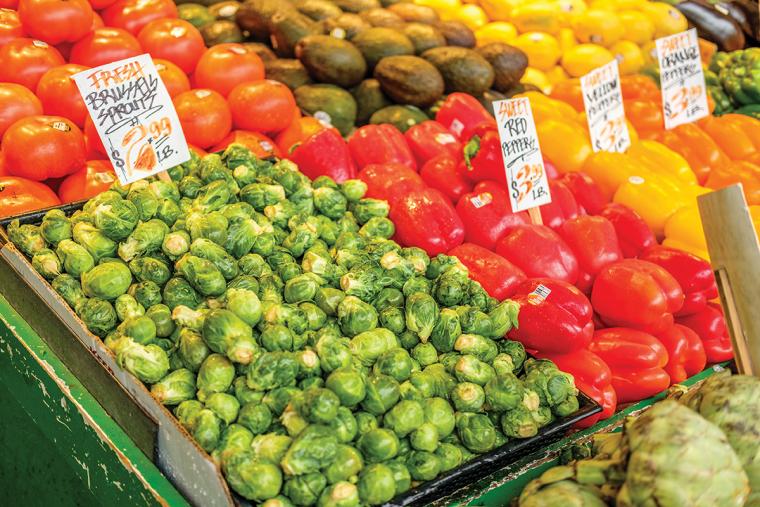
 With a population of more than 300 million, the United States boasts a sizable food industry. North America represents the largest global food market across all segments and the U.S. accounts for the lion’s share of that market. In 2014, U.S. consumers, businesses and government entities spent $1.46 trillion on food and beverages from grocery stores and other retailers, as well as foods, beverages and snacks purchased away from home.1 The average amount spent on food each year by a U.S. household reporting an average income totals $7,023.2
With a population of more than 300 million, the United States boasts a sizable food industry. North America represents the largest global food market across all segments and the U.S. accounts for the lion’s share of that market. In 2014, U.S. consumers, businesses and government entities spent $1.46 trillion on food and beverages from grocery stores and other retailers, as well as foods, beverages and snacks purchased away from home.1 The average amount spent on food each year by a U.S. household reporting an average income totals $7,023.2
Strong U.S. Food Market
The strength of U.S. food demand naturally leads to a healthy food manufacturing industry. During May 2015, the Bureau of Labor Statistics placed employment in the food processing sector at nearly 1.5 million workers. Annual payroll during this period amounted to approximately $57.5 billion.
If employment figures aren’t enough testament to the sector’s overall health, the industry itself proves to be very optimistic. Per “The WeiserMazars 2016 Food & Beverage Industry Study,” released in June by WeiserMazars LLP, most food and beverage companies anticipated a significant increase in sales in 2016. Survey participants — drawn from over 200 companies across the food and beverage industry — were confident that sales would show a 14 percent increase compared to 2015, and projected net profits to rise by 10 percent.3 That optimism has proven not unfounded – the latest industry figures from CSI Market cited net income in the food processing industry in the second quarter of 2016 as having improved by 53.95 percent over 2015, with quarter-over-quarter net income growth well above the manufacturing industry average.4
Attractive Market, Fueled by Trends
Given these statistics, it’s no wonder non-American-based food companies view the U.S. market as attractive. This sentiment is fueled not only by rising demand, but also by current food trends that weigh in the favor of foreign participation. Increasing diversity in U.S. population demographics has resulted in a less homogeneous market with rapidly changing consumer food preferences. This trend is highlighted by an enthusiastic interest in ethnic and culturally themed foods, as well as an increasing openness to experimentation with culturally diverse products and flavors. Americans are also keenly interested in food products that represent innovation and convenience.
Offshore food manufacturers are not unlike their U.S. counterparts in wanting and having the ability to capitalize on these current trends. The U.S. manufacturing sector draws the largest share of Foreign Direct Investment (FDI) dollars5 – food manufacturing accounts for a large portion of those dollars and contributes to significant employment of American workers.6
Usually, foreign food manufacturing firms establish their U.S. presence by importing their products into the U.S. When demand for these products reaches high levels, interest in locating permanent operations within U.S. borders naturally follows, for reasons of efficiency and cost-effectiveness. At this point, the search for a suitable location for a U.S.-based food manufacturing operation begins.
 Locating in the U.S.
Locating in the U.S.
There are a variety of factors influencing an offshore food manufacturer’s decision-making process when scouting a new U.S. plant location. Some of these factors are traditional in that they directly affect cost – not unlike those factors taken into consideration by a U.S.-based food manufacturer scouting a location for an additional facility in the states. Other considerations are unique to foreign food manufacturers seeking to locate onshore; these are indirectly related to cost, yet are important nonetheless as they stand to significantly influence the long-term success of the U.S. operation.
Traditional, Direct Cost Factors
Foreign food processing manufacturers seeking a facility location in the U.S. must first consider the traditional, direct cost factors involved with the site, including utilities, labor, logistics and taxation. By understanding the most important direct operation costs faced by the new company entering the U.S., the operation will be in a better position to determine if potential incentive and assistance programs offered by state and local governments can offset some operating costs and especially one-time startup costs.
• Utilities. Water availability, capacity, costs and quality are of utmost importance to any food manufacturer, regardless of origin. Food producers use water as an ingredient and for cleaning, sanitation and manufacturing purposes. It is vital they have an adequate and viable water supply for current and future use that follows the strict government standards that regulate the industry. Wastewater capacity, costs, ordinances and treatment, whether by local sewer or on-site management, should also be considered, as should the reliability of the electric power supply, the availability of natural gas and the service providers and redundancy of telecommunications.
• Labor. The availability of labor that meets operational requirements also is a critical factor for an international food processor entering the U.S. for the first time. A labor analysis, which assesses costs and skill levels, is an important step in determining whether there is a suitable workforce available to meet the food manufacturer’s needs. A region’s “labor shed” – knowing how far a potential workforce will travel for employment – must be understood by the company early in the community and site investigation phase of the project. Depending on required skill level, the availability of technical training schools and colleges in a community may also influence location decisions. To attract the required workforce, the site should be easily accessible to a sufficient pool of desired workers, by either public transportation or highway routes.
• Logistics. The fast and efficient transportation of inbound raw materials to the production facility and then outbound product to end user market concentrations is a primary determinant in a facility’s efficiency, profitability and success. Some estimates place outbound transportation (end products shipped to distribution centers, wholesalers and directly to end users such as retail establishments) as accounting for up to one-third of total annual operating costs. Getting site selection right based on logistical considerations, especially those related to outbound transportation, is vital to the ongoing success of the new facility and the food manufacturing organization.
• Taxation. State and local taxes also play an important role in overall operating costs for a company new to the U.S. Understanding how the company will be incorporated into the U.S. will dictate taxation policies that must be followed at the federal and state level. Once the company is incorporated and annual sales and investment have been determined, the firm will then need to assess individual business tax rates at the state level and potential annual liability by locating within the state. Local property taxes can be calculated in a similar manner based on anticipated investment in real and personal property.
• Incentives. Incentives offered by state and local economic development organizations (EDOs) must also be considered when a food manufacturer is scouting a location in the U.S. These incentives are usually financial in nature, with an eye toward lowering a company’s tax burden. Examples include abatements, exemptions or rebates for property, utilities, sales and usage. Performance-based cash grants also exist and are most often awarded based on fulfillment of projected employment levels, wage rates and investment numbers.
Aside from financial, there is a continuing trend toward offering other types of meaningful incentives for manufacturers to locate in a community. These include help with site development, workforce development and assistance with cutting through local red tape and making the permitting process more understandable, especially for a company unfamiliar with U.S. practices. Many international companies value the importance of a progressive state and local government in reducing one-time startup costs such as land prices, creation of a pad-ready site, elimination of any one-time water or waste water connection fee, or others that will assist in lowering or eliminating costs that directly determine a company’s decision to construct now or delay to a future time.

In addition to traditional cost-related factors, foreign food manufacturers seeking to establish a presence in the U.S. must also weigh a few subtler yet key considerations during the decision-making process. These factors, which include community compatibility and projections for future growth, are indirectly related to cost, but can have significant effect on the eventual success of the site and operation.
• Community compatibility. After assessing a community for its compatibility in terms of utilities, labor requirements, logistics, taxation and incentives, foreign food manufacturers should also assess the community based on other criteria. For example, it should be considered that if other food manufacturers are located nearby or within the region, the area will be accustomed to the typical overall needs of such an operation. The same holds true for an international presence in the community: if the community or region has other international companies located nearby, it will likely be more comfortable with the practical and cultural needs of a new foreign presence in the area. The last statement is especially true if foreign nationals and their families plan to relocate to the area.
• Future projections. It cannot be overstated that an educated prediction of the future growth and diversification of potential food product lines to be produced within a new facility is a key to long-term success. This is true for U.S. food manufacturers adding a new facility and is especially vital to foreign firms looking to build a facility in the states, since an international move means the stakes are high.
Therein lies one of the biggest challenges for food manufacturing site selection decision-makers today, regardless of origin: how to locate a facility that will suit today’s needs and continue to be a suitable and profitable site considering ever-faster-changing food product preferences and trends driven by an increasingly particular and changeable American marketplace?
In the past, when demand and production centered on processed foods, forecasting — and logistical networks — were based on volume and predicted volume increases due to simple population growth. Today, increased diversity in population demographics has resulted in more fragmented markets based on consumer food preferences. These preferences are also changing more rapidly than ever before.
Today’s food manufacturers have less time to distinguish between short-term fads and long-term trends, and then determine what products within their capabilities might be most marketable. New products must be researched, developed and brought to market with lightning-fast cycle times to be competitive in the modern marketplace. In this environment, only the most forward-thinking companies can accurately forecast emerging trends and determine their role in those trends with an eye toward profitability. It is an especially keen challenge for an international firm to predict trends in the American marketplace while based abroad.
Staying attuned to these demand-side trends, however, will help site selection decision-makers for international food processing firms evaluate a potential location based on its ability to adapt to potential future product strategies. Sound business forecasting and planning is essential to success.
 Evaluating a U.S. Site Location for Foreign Food Manufacturers — A Checklist
Evaluating a U.S. Site Location for Foreign Food Manufacturers — A Checklist
The complexity of site evaluation for a foreign food manufacturer seeking to locate a U.S. plant cannot be overstated.
To simplify the process, the following checklist can be used as a guide to ensuring a thorough, detailed evaluation is conducted.
1. Traditional, direct cost factors
a) Utilities
1) Water
2) Wastewater/effluent
b) Labor
1) Current availability
2) Potential for training
c) Logistics
1) Inbound
2) Outbound
d) Taxation
1) State
2) Local
e) Incentives
1) Traditional
2) Non-traditional
2. Indirect, influencing factors
a) Community compatibility
1) Former food manufacturing presence
2) Former international presence
b) Future projections
1) Potential future products
2) Potential future target markets.
Footnotes:
1 http://www.ers.usda.gov/data-products/ food-expenditures.aspx
2 www.bls.gov/news.release/cesan.nr0.htm
3 http://www.weisermazars.com/images/foodbeveragesurvey2016.pdf
4 http://csimarket.com/Industry/Industry_ Growth.php?ind=505
5 https://www.whitehouse.gov/sites/default/ files/2013fdi_report_-_final_for_web.pdf
6 http://www.bea.gov/international/ di1fdiop.htm


